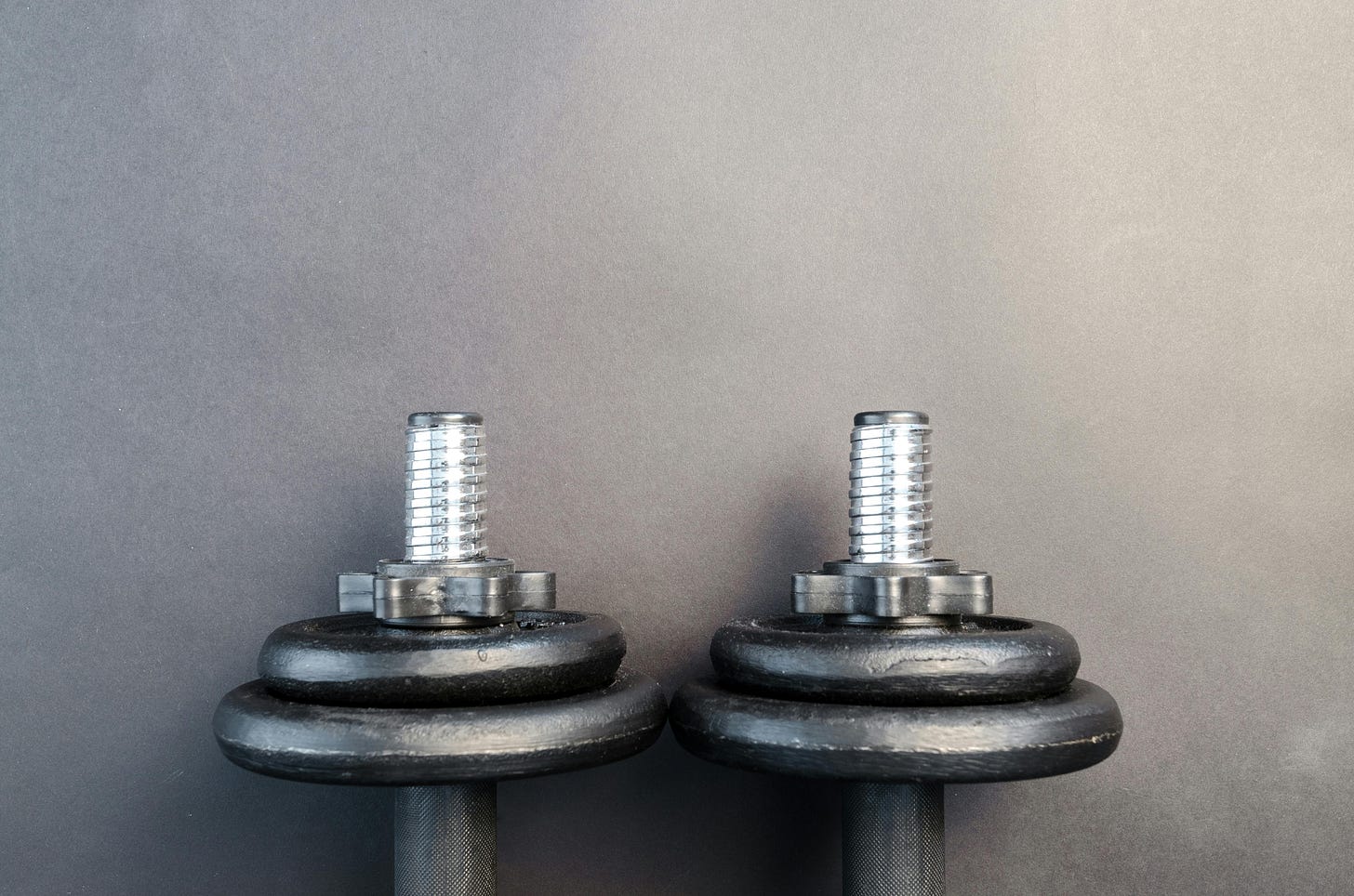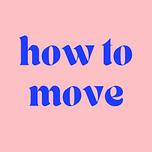
I’ve been thinking a lot about the concept of failure lately — not in life or work (as my beloved colleague Dana G. Smith used to say during our weekly Covid-era team Zoom checkins, “I’m fine, it’s fine, everything is fine!!!”), but in the gym.
It’s a tricky thing, and you may not even have heard of or thought about it! But I wanted to give an introduction and overview in case you find it helpful in your own movement routine. So give this little voice memo a listen (transcript is below). I’ll include a couple of links at the end if you’d like to learn more.
I thought I’d try kind of sending you a voice memo about something I’ve been thinking about, and have gotten a couple of questions about recently, which is the idea of working to failure, or working close to failure, in the context of a strength / resistance-training workout.
Before I get into it, I want to repeat what’s probably my favorite little motto around here which is, let’s not let what’s optimal get in the way of what’s sustainable. (Or even just what’s doable.) There is SO MUCH information out there about fitness and optimizing our wellbeing these days — I imagine my Instagram is a lot more fitnessy than yours probably is, because I work in this space, but oh man, it gets really overwhelming. You can really get pulled into some rabbit holes and start questioning whether you actually have any clue what you’re supposed to be doing. (You can also get pulled into some dangerous and triggering rabbit holes, but that’s another story. But do be careful out there. Not to be all put the phone down, but yeah, put the phone down.)
So in this context what I mean by that is, if you’re maybe just starting out, or you’ve had a really long break since you last exercised, maybe you’re rebuilding a movement habit after a period where your exercise approach maybe wasn’t all that supportive to your wellbeing — maybe you are dealing with injury or illness or recovering from childbirth, trauma, you name it — it may not actually be that great a time to think about something like working to failure. You might be in a season where the main goal of movement is simply to move, and maybe to figure out what kind of movement you enjoy, what approach to movement allows you to do it on a regular basis. What feels good and supportive in your body. You might even be in a space where you’re not actually ready to even start moving, but you’re thinking about it and maybe trying to make some plans.
All of that is normal and good, and important to make space for. This noise about optimization can get really distracting and discouraging. So tune it out if you can, if you know that this kind of thing just isn’t where you’re at right now. It’s fine. Maybe you work toward it! Maybe not, and you’re just focused, again, on movement that feels really great long-term.
That said, maybe you are a regular exerciser, or maybe you’re someone who’s done a lot of running or yoga or some other modality and you’re getting more into strength training. Or you’ve been doing weight workouts for a while but want to try to get a little more out of them. If that is you, then let’s talk a little about failure.
The idea of working to failure is basically, when you’re doing a resistance exercise, whether it’s a squat or a bicep curl or a lat pulldown or whatever, is that at the end of your set, you cannot physically complete another rep. Now, not to get too in the weeds, but there are two types of failure: one is technical failure, where you can’t do another rep with proper form, but maybe if you kinda compensate or use other muscles to kind of hork it up, you can complete the lift. The other is muscular failure, which means you can’t do the move at all, even with super wonky form.
For a long time, there’s been a belief that you really need to work to failure in order to build muscle, but research and experts are suggesting nowadays that working close to failure — where maybe you could do a rep or two more, but it would be really really hard — might be a good sweet spot for building muscle mass, improving bone density, all those good things, without some of the drawbacks of working all the way to failure. Those being things like extreme soreness, fatigue, and of course, if you’re in technical failure and using weird muscles to finish your set, you might be at risk for injury.
So, I want to back up for a minute and say that in my experience, women exercisers haven’t necessarily historically been pushed or encouraged to work to failure or close to failure. Until maybe 10 years ago when I started learning more about lifting weights, I think the only time I’d really experienced it was in, like, a barre class, where you’re doing 10,000 tricep extension pulses and you feel like your arm is going to fall off. (Which is failure, by the way! We’ll talk more about weight versus reps in a minute.) We weren’t encouraged to lift heavy at all, and even if we were told to squat or deadlift or whatever, we were given sort of a generic medium to heavy weight, 8-12 reps, with no discussion of what those final reps should look or feel like.
I wonder if part of that is the challenge of group fitness: I can say firsthand that in teaching a group class (or even making a video for lots of people to consume!), it’s pretty challenging to communicate the nuances of how to approach the lifts. Especially since many people, again, might be in that category where working close to failure might just kind of be discouraging or a distraction from that super-important goal of just moving and finding a really sustainable approach to exercise.
Anyway, obviously there’s this big strength training revolution happening right now, more women are doing it, more people are talking about it, and in particular, people are talking about the importance of resistance training for combating the loss of muscle mass and bone mineral density that happens as we age. And it turns out that it’s not just resistance training, it’s specifically lifting heavy, ideally with a progressive overload approach, that really helps us build and maintain that mass and density to help us stay strong, resilient, and as healthy as we can be as we age.
Now for the general population overall, there’s some debate about whether working to failure has to come from using the heaviest possible weights, or whether you might get similar benefits from lighter weights but much higher reps (like what you’d do in a barre class, or maybe somewhere in between — medium weights, medium reps). And I would say that if you feel really intimidated by the idea of working to failure, playing with volume in this other way — not super heavy, but lots of reps — might be a good entry point.
But I do think it’s important to be frank that the research seems to suggest that for people who are perimenopausal and beyond, heavy weights that allow you to get close to failure at a pretty low rep count might be the best way to go. And that helps you build true strength and power, not just endurance. That said, there are some people with certain health conditions that really cannot lift heavy, and I don’t want you to feel like you can’t still build muscle. Again, not letting the optimal block the doable! So if high reps with low weight is a better fit for you, do it with pride and confidence.
So what does this actually look like in practice? Let’s talk overall and then talk about how it might play out in an individual workout:
So overall, again, you want to figure out your own very individual starting point. If you are totally new to strength training, you’re honestly going to want your first few workouts to be using bodyweight. Even in CrossFit, you go through an onramp program over the course of a few sessions where you learn all the lifts using PVC pipes, which if you’ve never used basically weigh like one or two pounds. And then you can start using barbells, but if you’re in a good gym you’re probably still encouraged to keep it relatively light until you get more used to the movements. Even with those PVC pipes, you’re probably going to be really sore! Part of it is learning and getting comfortable with the movements from a neuromuscular perspective and part of it is avoiding totally wrecking yourself with soreness.
So again, when you feel ready — maybe that’s a few days or a few weeks or even a few months — you start to add weight. Maybe they’re really light at first, or light to medium. And then you work your way up to weights that feel pretty challenging but still doable.
And then, maybe it’s time to start really pushing that weight. And this might be for literally one lift per session. Let’s say you’re doing four or five exercises — you can pick one that you’re really going to go for it and push yourself to the brink of failure. The others, you should be working hard, but maybe not all the way to almost-failure.
Over time, maybe you get to a point where three-ish out of those four or five lifts are getting you close to failure. And I am saying maybe for a few reasons: One, everyone is different and individual. You need to go with what works for you. And two, if you’re working on a specific program with a specific goal in mind, the parameters of your program may differ from what I’m saying here; I don’t mean to try to override any great trainers or coaches you’re working with, this is just meant as general guidance or food for thought.
What does it feel like to get to failure? Let’s say you’re doing an overhead press with dumbbells. You’re starting with the dumbbells right in front of your shoulders and pushing them up overhead, fully extending your elbows. Well, you do a few reps as such, and then you start to slow down a little bit because it’s getting really spicy. And then you come to a rep where you are really, really struggling — it takes a super long time to get those weights overhead, and you just know that if you tried another rep it would be super messy and you might not actually be able to complete it. That’s about what we’re going for.
I do want to make a note about safety here. There are certain lifts where working close to failure can be a little tricky because of the setup. This is why, for example, when you’re bench pressing with a barbell, you need a spotter — if you’re lifting heavy enough to be tiptoeing around failure, there’s a good chance you might get kinda trapped under that bar. So some lifts really require a spotter, others require some training in how to “bail” — if you’re squatting with a barbell, you need to know how to kinda toss that bar off your back behind you so you don’t get stuck. So keep that in mind. I’m happy to answer more questions about that.
And again, we’re really trying to work close to failure, not all the way to failure. It’s of course OK if you try a rep and can’t complete it. But you don’t have to go all that way in order to gain the benefits. It’s more that the final rep or two should feel very, very hard and you know you couldn’t complete another one.
If you do my workouts here on How to Move, you know that I don’t usually prescribe rep counts when we’re lifting. I usually work with a one-minute working session or opportunity. So I’ve mentioned this before but just want to reiterate, that’s an opportunity and not a prescription: I don’t need you to be working for that full minute, and in fact, if you’re able to complete reps with no problem at all for the whole minute, you might want to consider adding weight until you are able to get to this “close to failure” feeling.
And by the way, one thing I really love about working close to failure, aside from the fact that you get a lot stronger a lot more quickly, is that it really requires mindfulness: You have to really pay attention to your body, how it’s feeling, what it’s capable of. You have to stay curious and dialed in to reach the point we’re talking about, and you’ll likely notice so much more about your response to the work you’re doing. Which is really cool.
Listen, I know this might seem like a lot, and I don’t want to overwhelm you or make you feel discouraged if you have an exercise thing going that’s really working for you. Think of this as food for thought, and maybe something to work toward or consider incorporating in the future.
I hope this was helpful and not too overwhelming. I’m planning to do some interviews about all of this with some experts who know way more about it than I do! So please let me know your questions and I’ll definitely work on getting you some answers.
Thanks for listening!
Helpful links:
“How Hard Do You Have to Push Yourself to Get Stronger?” by Alyssa Ages. The New York Times, May 3, 2025.
“The Pros and Cons of Training to Failure—Plus How to Do It Properly,” by Sarah Klein. OnePeloton.com, December 6, 2024.
“Strength Training During Perimenopause,” by Carly Smith and Stacy Sims, PhD. Stanford Lifestyle Medicine, July 11, 2023.
“Strength and Hypertrophy Adaptations Between Low- vs. High-Load Resistance Training: A Systematic Review and Meta-analysis,” by Brad Shoenfeld, PhD, et al. Journal of Strength and Conditioning Research, December 2017.
xo
Anna













Share this post